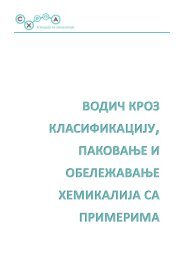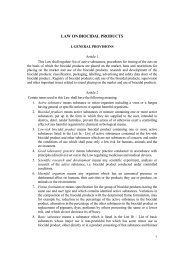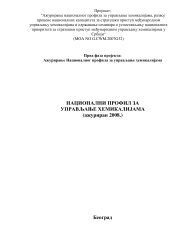GHS (CLP/GHS system) IN PRACTICE - Agencija za hemikalije
GHS (CLP/GHS system) IN PRACTICE - Agencija za hemikalije
GHS (CLP/GHS system) IN PRACTICE - Agencija za hemikalije
You also want an ePaper? Increase the reach of your titles
YUMPU automatically turns print PDFs into web optimized ePapers that Google loves.
1. <strong>IN</strong>TRODUCTION1.0 BackgroundThe purpose of this document is to give suppliers, professional users of ha<strong>za</strong>rdous chemicals as well as generalpublic basic information on <strong>GHS</strong>, <strong>CLP</strong> Regulation and Serbian <strong>CLP</strong>/<strong>GHS</strong>. In this manual you will also find theanswers on the FAQ in the filed of chemicals in Serbia.The full official text of the <strong>CLP</strong>/<strong>GHS</strong> Rulebook (“Official Gazette of RS” No 64/10) is available on the followingweb link: http://www.ekoplan.gov.rs/shema/1.1 What is <strong>GHS</strong>? How it is developed and its main goal?Development of <strong>GHS</strong>The <strong>GHS</strong> is an acronym for The Globally Harmonized System of Classification and Labelling of Chemicals. It is a<strong>system</strong> for standardizing and harmonizing the classification and labelling of chemicals.The <strong>GHS</strong> Document, so called "The Purple Book", is not a regulation or a standard but global agreement. Itestablishes agreed ha<strong>za</strong>rd classification and communication provisions with explanatory information on how toapply the <strong>system</strong>. The elements in the <strong>GHS</strong> supply a mechanism to meet the basic requirement of any ha<strong>za</strong>rdcommunication <strong>system</strong>, which is to decide if the chemical is ha<strong>za</strong>rdous and to prepare a label and Safety DataSheet (SDS) as appropriate.Across the world, countries have different rules on classification and labelling. For example, a chemical could beclassified as ‘toxic’ or ‘explosive’ in one country but not in another. Different symbols are also used to indicate thesame ha<strong>za</strong>rds. Therefore 20 years ago the need to develop a single, globally harmonized <strong>system</strong> to addressclassification of chemicals, labels, and SDS was recognized.The most important force that drove the creation of the <strong>GHS</strong> was the international mandate adopted in the 1992United Nations Conference on Environment and Development (UNCED), "Earth Summit". The harmoni<strong>za</strong>tion ofclassification and labelling of chemicals all over the world was one of six program areas that were endorsed by theUN General Assembly to strengthen international efforts concerning the environmentally sound management ofchemicals. It was recognized that an internationally harmonized approach to classification and labelling wouldprovide the foundation for all countries to develop comprehensive national programs to ensure the safe use ofchemicals.The main goals of <strong>GHS</strong>:.1 SUBSTANCE1 CLASSIFICATION1 LABEL1 SAFETY DATA SHEET (SDS)all over the world!The first version of the <strong>GHS</strong> Document was approved by the Committee of Experts in year 2002 in Geneva. Afterthat <strong>GHS</strong> has been regularly amended. So <strong>GHS</strong> is driven and developed at UN level. In order to amend it youmust feed into the UN discussion. The third revised edition of the <strong>GHS</strong> was published in 2009.The Plan of Implementation of the World Summit on Sustainable Development (WSSD), adopted in Johannesburgin 2002, encourages countries to implement the <strong>GHS</strong> as soon as possible. Information about the status ofimplementation of the <strong>GHS</strong> by country is available onhttp://www.unece.org/trans/danger/publi/ghs/implementation_e.html.3
















